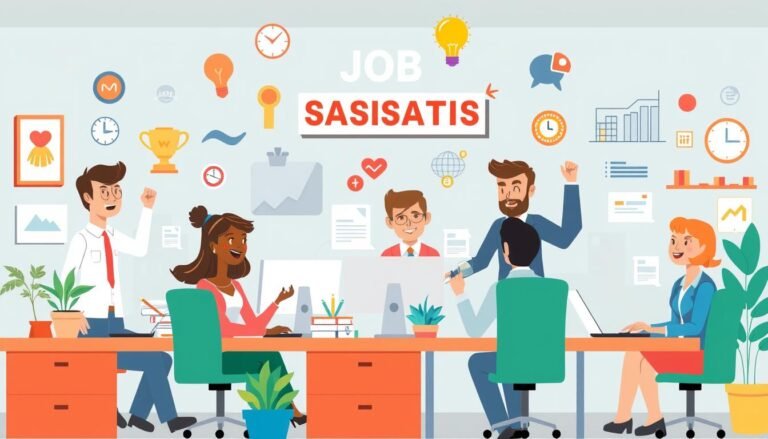Workplace Bullying: A Psychological Guide to Addressing Toxic Behavior
Ever felt a knot in your stomach before work, fearing the day? You might be dealing with workplace bullying. This harmful behavior affects millions worldwide but often goes unnoticed. Let’s explore how to make work places better.
Workplace bullying is more common than you think. About 30% of American workers say they’ve been bullied at work, the Workplace Bullying Institute reports. Even more shocking, 43% of remote workers face bullying, showing it’s not just office-based.
The effects of workplace bullying are serious. It can cause mental health issues, lower productivity, and even physical health problems. For example, it’s linked to heart disease and chronic pain.
This guide aims to highlight workplace bullying’s many sides. We’ll look at spotting toxic behavior, its causes, and how to fight it. Whether you’re an employee, manager, or HR pro, this guide will help you tackle this big issue.
Key Takeaways
- Workplace bullying affects 30% of American workers
- Remote workers also experience high rates of bullying (43%)
- Bullying can lead to mental health issues and physical health problems
- Certain industries, like healthcare and education, report higher bullying rates
- A “psychosocial safety climate” in workplaces may reduce bullying incidents
- Documenting bullying incidents is crucial for effective resolution
Understanding Workplace Bullying: Definition and Prevalence
Workplace bullying is a big problem in the U.S., affecting millions. It’s when someone is bullied at work, making it hard to do their job. This can include mean words or being left out, hurting both people and companies.
What Constitutes Workplace Bullying
Workplace bullying is when someone is bullied over and over again. It can be scary, embarrassing, or make it hard to do your job. It’s not the same as getting feedback to improve, because bullying is meant to hurt.
Statistics on Workplace Bullying Occurrence
Recent studies show how common workplace bullying is:
- 30% of Americans have been bullied at work
- 19% have seen someone being bullied
- 48.6 million Americans have been bullied at work
- Bullying has gone up by 57% since 2017
| Category | Percentage |
|---|---|
| Non-management employees bullied | 52% |
| Managers bullied | 40% |
| Bullies who outrank their victims | 72% |
Differences Between Bullying and Harassment
Harassment and bullying both make work hard, but they’re different. Harassment is about being mean because of who you are, like your race or gender. Bullying can happen to anyone, not just because of who they are. Harassment is against the law, but bullying might not be, depending on where you live.
“Workplace bullying is a silent epidemic, affecting nearly half of all American workers either directly or indirectly.”
Types of Workplace Bullying
Workplace bullying takes many forms, causing harm to both employees and companies. Knowing these types is key to stopping mistreatment.
Verbal Bullying in the Workplace
Verbal abuse is a common workplace bully. It includes insults, threats, and constant criticism. This can really hurt an employee’s self-esteem and job skills.
Cyberbullying Among Coworkers
Cyberbullying has grown with digital tools. It’s when people use social media or online chats to mock or scare others. About 15% of adults say they’ve been cyberbullied, with the young being most affected.
Social Exclusion and Isolation Tactics
Some bullies isolate people from their coworkers. This makes the workplace very hostile. It can make people less productive and more stressed.
Sabotage and Work Interference
Work sabotage is a serious bullying act. It’s when someone gives unclear instructions or sets impossible deadlines. This can really hurt someone’s job and career chances.
| Type of Bullying | Prevalence | Impact on Productivity |
|---|---|---|
| Verbal Bullying | 31% | 30% decrease |
| Cyberbullying | 15% | 25% decrease |
| Social Exclusion | 28% | 40% decrease |
| Work Sabotage | 26% | 35% decrease |
It’s important to know about these bullying types to make work better. Companies that tackle these problems can lower employee leaving and boost work output.
Psychological Impact of Workplace Bullying
Workplace bullying is a serious form of psychological abuse. It can deeply harm mental health. Studies reveal that 30% of workers have faced bullying, and this number jumps to 43.2% for those working remotely. This issue affects not just the bullied but also those who see it happen.
The mental health effects of workplace bullying are severe and long-lasting. Victims often feel more stressed, have low self-esteem, anxiety, and depression. Research shows bullying can lead to mental health issues up to two years later. Men may even face mental health problems up to five years after being bullied.
Physical symptoms also show up due to workplace bullying. These can include:
- High blood pressure
- Panic attacks
- Ulcers
- Headaches
- Muscle tension
- Changes in appetite
- Sleep disturbances
Bullying also affects work performance. Bullied workers may work less efficiently, miss more days, and have trouble focusing. This not only hurts the person but also makes the workplace hostile. It can lead to higher costs for employers due to turnover and health care expenses.
“Workplace bullying is a silent epidemic that undermines both individual and organizational health. It’s crucial we recognize and address this issue to foster healthier, more productive work environments.”
It’s vital to tackle workplace bullying to ensure a safe work environment. By understanding its effects, companies can work to stop and lessen the harm caused by bullying.
Identifying Signs of a Toxic Work Environment
It’s important for both employees and employers to spot a toxic workplace. A bad work environment can lower productivity, morale, and well-being. Let’s look at signs of workplace toxicity and how they affect teamwork.
Common Indicators of Workplace Toxicity
Workplace toxicity shows up in many ways. A survey by The Muse found 64% of workers have faced toxicity at work. High turnover rates often mean a toxic workplace, due to bad leadership, lack of resources, and unfair pay.
Impact on Team Dynamics
Toxic behavior hurts team dynamics. It breaks trust, blocks creativity, and makes teamwork hard. Teams in toxic places often see less productivity and more conflict. This can lead to more absences and fewer new projects.
| Year | Turnover Rate (%) | Absenteeism Increase (%) |
|---|---|---|
| 2020 | 25 | 10 |
| 2021 | 30 | 15 |
| 2022 | 35 | 20 |
Recognizing Subtle Forms of Bullying
Subtle bullying is hard to spot but is very harmful. It includes being left out, not sharing info, or being passive-aggressive. These actions make a work place hostile, causing more anxiety and depression. Spotting these signs early helps fix the problem and create a better work culture.
Root Causes of Bullying Behavior in the Workplace
Workplace aggression comes from many sources. It often starts with the bully’s personality and the work setting. Knowing these reasons is key to stopping abusive behavior and protecting employees.
Studies reveal that bullies often have certain traits. They are outgoing, disagreeable, and skilled at manipulation. Some have narcissistic tendencies or lack empathy. These traits can cause harm to others and disrupt team harmony.
There are many reasons why people bully at work. Envy is a big one, especially towards high achievers and popular coworkers. Bigoted beliefs and unresolved anger can also lead to aggression.
“Nearly one-third of all employees experience workplace bullying at some point during their careers, impacting about 48.6 million Americans annually.”
Workplace issues also play a part. Companies going through changes or facing high demands can foster bullying. Job insecurity and power imbalances can push people to bully others to feel powerful.
| Common Bullying Behaviors | Potential Root Causes |
|---|---|
| Verbal abuse | Anger management issues |
| Social exclusion | Need for control |
| Sabotage | Envy of others’ success |
| Excessive criticism | Insecurity about own performance |
To fight workplace bullying, we need a broad strategy. Companies should promote respect, have clear anti-bullying rules, and support victims. By addressing the root causes, we can make workplaces safer and more respectful.
The Role of Organizational Culture in Fostering or Preventing Bullying
Workplace culture is key in shaping how we act at work. A good culture stops bullying, while a bad one encourages it. Around 50% of workers worldwide face bullying or disrespect from their bosses or colleagues.
How leadership influences workplace behavior
Leaders set the tone in the workplace. When they act with respect and handle problems quickly, it inspires others. But, if leaders ignore or support bullying, it can spread harm.
The importance of clear anti-bullying policies
Having clear policies against bullying is vital. They tell everyone what’s okay and what’s not, and what happens if you cross the line. Good policies help keep the workplace safe and respectful.
Creating a psychosocial safety climate
A safe work environment is essential to stop bullying. It’s about making sure everyone feels safe and valued. Companies that focus on this have fewer bullying problems.
| Sector | Bullying Rate | Impact on Employees |
|---|---|---|
| Healthcare | 45% | Heightened psychological stress |
| General Workforce | 50% | Increased job turnover |
| Organizations with Strong Policies | Lower rates | Improved job satisfaction |
Building a positive work culture takes hard work and dedication. By focusing on safety and clear rules, companies can cut down bullying. This makes the workplace a better place for everyone.
Strategies for Victims to Address Workplace Bullying
Victims of workplace bullying often feel trapped. But, there are ways to fight back and protect your rights. Start by speaking up early. Don’t let the problem grow. Keep a record of each incident, including dates, times, and who was there.
Find support from people you trust or professionals. They can offer emotional support and back up your story. Remember, fighting bullying is about standing up for your rights, not getting revenge.
Stay professional when dealing with bullying. This makes your case stronger if you need to take action. Think about your options. Many places have ways to report bullying. Use them.
“No one deserves to be bullied at work. Stand up for yourself and others.”
Take care of yourself when dealing with work stress. Make time to relax and recharge outside of work. This helps you stay strong against ongoing challenges.
| Strategy | Benefits |
|---|---|
| Document incidents | Provides evidence, helps identify patterns |
| Seek support | Emotional backup, potential witnesses |
| Use reporting mechanisms | Formal action, organizational involvement |
| Practice self-care | Increased resilience, stress management |
By taking these steps, victims can fight workplace bullying and make their work environment better for everyone.
Employer Responsibilities in Combating Workplace Bullying
Employers are key in making workplaces safe. The Occupational Health and Safety Act 2004 requires them to keep workplaces free from bullying. This goes beyond just following the law. It also helps keep employees happy and productive.
Implementing effective anti-bullying policies
Workplace policies are the first step in stopping bullying. They should clearly state what is expected and how to report bullying. Leaders must enforce these policies, showing everyone the right way to act.
Being open about how bullying is handled builds trust. It also encourages people to speak up sooner.
Training programs for managers and employees
Training is vital for spotting and stopping bullying. New employees should learn about anti-bullying rules right away. Training for everyone helps spot even the smallest signs of bullying.
Managers need special training to deal with bullying reports. This helps them create a respectful workplace.
Establishing reporting mechanisms and support systems
It’s important to have clear ways for employees to report bullying. Employers should offer different ways to report incidents privately. Having support, like counseling, helps those affected by bullying.
Acting quickly on reports shows the company is serious about stopping bullying. This helps everyone feel safe and valued.
| Prevention Measure | Impact |
|---|---|
| Clear anti-bullying policies | Sets behavior standards |
| Regular employee training | Improves awareness and response |
| Confidential reporting systems | Encourages early intervention |
| Management commitment | Fosters a positive work culture |
Legal Aspects and Employee Rights in Cases of Workplace Bullying
Workplace bullying is a big problem in the U.S., affecting nearly 30% of workers. It can cause serious mental health issues like depression and anxiety. Even though bullying isn’t always illegal, workers have the right to a safe workplace.
In California, the Fair Employment and Housing Act (FEHA) protects workers from hostile environments. It covers many groups, including age, ancestry, gender identity, and race. If bullying targets these groups, it may be illegal.
Federal laws also protect workers. Title VII of the Civil Rights Act, the Americans with Disabilities Act, and the Age Discrimination in Employment Act can apply. For bullying to be illegal, it must be severe or linked to job security.
Employers can be held accountable for bullying by supervisors, co-workers, or even outsiders. They must act if they know about harassment. Federal employees have specific steps to follow when reporting bullying.
| Timeline | Action |
|---|---|
| 180 days | Agency investigation period |
| 30 days | Window to request hearing |
| 90 days | Appeal period after agency decision |
It’s important to know your rights and the laws at work. If you’re bullied, document what happens and report it. If it doesn’t stop, get legal advice.
Long-term Consequences of Unaddressed Workplace Bullying
Workplace bullying can have serious and lasting effects. It goes beyond just making someone uncomfortable. It can harm careers, health, and even the company’s finances.
Impact on Individual Career Progression
People who are bullied at work often struggle to move up in their careers. A Monster.com poll found that 90% of people have experienced bullying at work. This makes them less happy at their job, less creative, and less likely to work well with others.
Organizational Costs of Bullying
Bullying at work costs companies a lot of money. It’s estimated to cost over $2 billion in health organizations alone. The costs come from:
- Less work getting done
- More time off for sick leave
- Legal fees from lawsuits
- More people leaving their jobs
Health Implications for Victims
Bullying at work can really hurt people’s health. Targets often face:
| Physical Health Issues | Mental Health Issues |
|---|---|
| Heart disease | Depression |
| Type II diabetes | Anxiety |
| Problems sleeping | Post-traumatic stress disorder |
Research shows bullying can make these health problems worse. This shows we need to stop bullying at work fast.
Conclusion
Workplace bullying prevention is a big deal that needs attention from everyone at work. Studies have shown how common and harmful toxic behavior is in many jobs. A 2020 study found that stopping workplace bullying works well in Norway’s industrial sector.
To make work places better, we need to do many things. Research links bullying to burnout, showing we need to be emotionally smart and strong. Companies should build a culture that doesn’t tolerate bullying and encourages talking openly. The pandemic has made it clear we must tackle toxic behavior in our changing work world.
Stopping toxic behavior means using bystander methods, which help fight sexual harassment at work. These methods work well when they fit the situation. By focusing on changing the workplace and supporting bystanders, businesses can make work safer and better for everyone. Fighting workplace bullying helps not just employees but also the company’s success and image.
Source Links
- Bullying at Work – HelpGuide.org
- Tackling Workplace Bullying: A Comprehensive Guide
- Combating Workplace Bullying – Toward a Respectful Workplace
- Workplace bullying takes an emotional, physical toll; support is in place to help
- Workplace bullying
- Workplace Bullying: 5 Types & How To Combat It in 2023
- No title found
- Watch out for these 8 workplace bully personality types | HRMorning
- What Are the Effects of Workplace Bullying?
- Workplace Bullying: A Tale of Adverse Consequences
- Toxic Workplace Checklist: 14 Signs to Look Out For | Talkspace
- Identifying the Warning Signs of a Toxic Work Environment
- Bullying in the Workplace
- How Workplace Bullies Pick Their Targets
- Workplace bullying: what is it, symptoms and treatment | Top Doctors
- The impacts of organizational culture and neoliberal ideology on the continued existence of incivility and bullying in healthcare institutions: A discussion paper
- Lean and Mean: Workplace Culture and the Prevention of Workplace Bullying
- Standing up against workplace bullying behavior: Recommendations from newly licensed nurses
- Bullying in the Workplace
- How HR managers should deal with workplace bullying | Culture Shift
- Preventing workplace bullying | WorkSafe Victoria
- Workplace Bullying
- Workplace Bullying
- Bullying In The Workplace Under Federal Law | FEDLaw
- Impact of Workplace Bullying Amongst First Responders- Systematic Review
- Workplace incivility as a risk factor for workplace bullying and psychological well-being: a longitudinal study of targets and bystanders in a sample of swedish engineers – BMC Psychology
- A guide to workplace bullying – TestGorilla
- Impact of workplace bullying on work engagement among early career employees
- Encourage. Support. Act! – Conclusion







